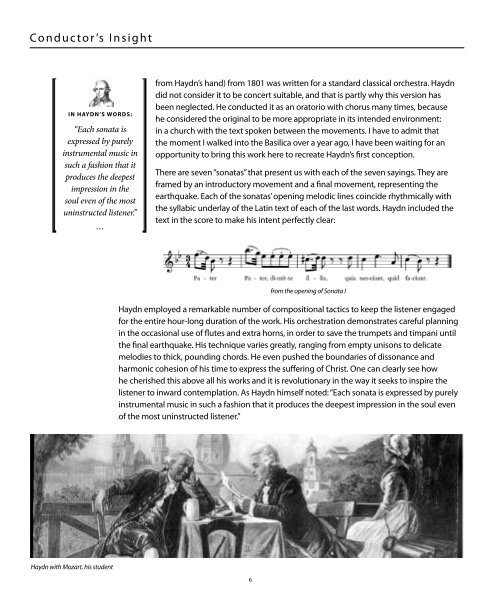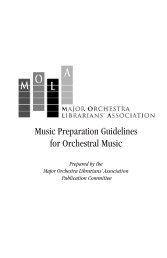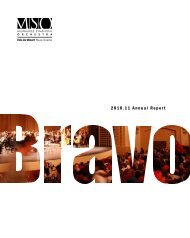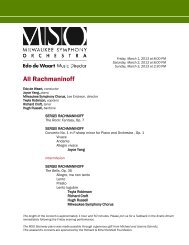contemplation - Milwaukee Symphony Orchestra
contemplation - Milwaukee Symphony Orchestra
contemplation - Milwaukee Symphony Orchestra
Create successful ePaper yourself
Turn your PDF publications into a flip-book with our unique Google optimized e-Paper software.
Conductor’s Insight<br />
Conductor’s Insight<br />
in Haydn’s words:<br />
“Each sonata is<br />
expressed by purely<br />
instrumental music in<br />
such a fashion that it<br />
produces the deepest<br />
impression in the<br />
soul even of the most<br />
uninstructed listener.”<br />
…<br />
from Haydn’s hand) from 1801 was written for a standard classical orchestra. Haydn<br />
did not consider it to be concert suitable, and that is partly why this version has<br />
been neglected. He conducted it as an oratorio with chorus many times, because<br />
he considered the original to be more appropriate in its intended environment:<br />
in a church with the text spoken between the movements. I have to admit that<br />
the moment I walked into the Basilica over a year ago, I have been waiting for an<br />
opportunity to bring this work here to recreate Haydn’s first conception.<br />
There are seven “sonatas” that present us with each of the seven sayings. They are<br />
framed by an introductory movement and a final movement, representing the<br />
earthquake. Each of the sonatas’ opening melodic lines coincide rhythmically with<br />
the syllabic underlay of the Latin text of each of the last words. Haydn included the<br />
text in the score to make his intent perfectly clear:<br />
F. Holland Day, The Seven Last Words of Christ, 1898, Prints & Photographs Division, Library of Congress, Washington, D.C.<br />
The Seven Last Words of Christ on the Cross English with Latin text<br />
forgiveness<br />
I. When they came to the place that is called The Skull, they crucified Jesus there with the criminals,<br />
one on his right and one on his left. Then Jesus said, “Father, forgive them; for they do not know<br />
what they are doing.”<br />
Pater, dimitte illis, quia nesciunt, quid faciunt. Luke 23:34<br />
from the opening of Sonata I<br />
Haydn employed a remarkable number of compositional tactics to keep the listener engaged<br />
for the entire hour-long duration of the work. His orchestration demonstrates careful planning<br />
in the occasional use of flutes and extra horns, in order to save the trumpets and timpani until<br />
the final earthquake. His technique varies greatly, ranging from empty unisons to delicate<br />
melodies to thick, pounding chords. He even pushed the boundaries of dissonance and<br />
harmonic cohesion of his time to express the suffering of Christ. One can clearly see how<br />
he cherished this above all his works and it is revolutionary in the way it seeks to inspire the<br />
listener to inward <strong>contemplation</strong>. As Haydn himself noted: “Each sonata is expressed by purely<br />
instrumental music in such a fashion that it produces the deepest impression in the soul even<br />
of the most uninstructed listener.”<br />
salvation<br />
compassion<br />
angst<br />
resignation<br />
credence<br />
acceptance<br />
II. One of the criminals who were hanged there kept deriding him and saying, “Are you not the Messiah?<br />
Save yourself and us!” But the other rebuked him, saying, “Do you not fear God, since you are under<br />
the same sentence of condemnation? And we indeed have been condemned justly, for we are<br />
getting what we deserve for our deeds, but this man has done nothing wrong.” Then he said,<br />
“Jesus, remember me when you come into your kingdom.” He replied, “Truly I tell you, today you<br />
will be with me in Paradise.”<br />
Hodie mecum eris in Paradiso. Luke 23:43<br />
III. When Jesus saw his mother and the disciple whom he loved standing beside her, he said to his<br />
mother, “Woman, here is your son.”<br />
Mulier, ecce filius tuus. John 19: 26 –7<br />
IV. At three o’clock Jesus cried out with a loud voice, “Eloi, Eloi, lema sabachthani?” which means,<br />
“My God, my God, why have you forsaken me?”<br />
Deus meus, Deus meus, utquid dereliquisti me? Mark 15: 34<br />
V. After this, when Jesus knew that all was now finished, he said (in order to fulfill the scripture), “I thirst.”<br />
Sitio. John 19: 28<br />
VI. A jar full of sour wine was standing there. So they put a sponge full of the wine on a branch of hyssop<br />
and held it to his mouth. When Jesus had received the wine, he said, “It is finished.”<br />
Consummatum est. John 19: 30<br />
VII. Then Jesus, crying with a loud voice, said, “Father, into your hands I commend my spirit.” Having said<br />
this, he breathed his last.<br />
In manus tuas, Domine, commendo spiritum meum. Luke 23:46<br />
Haydn with Mozart, his student<br />
6<br />
7








